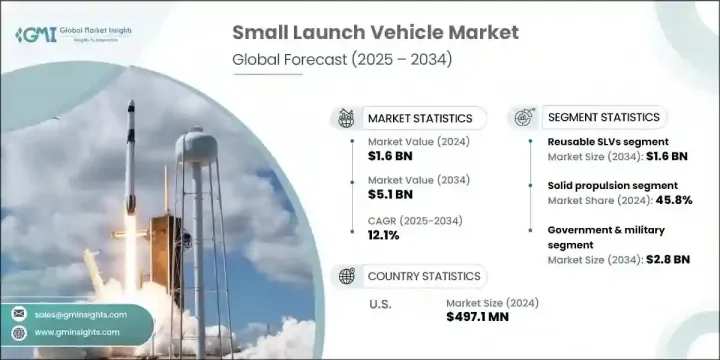
|
시장보고서
상품코드
1797781
소형 발사체 시장 기회, 성장 촉진요인, 산업 동향 분석 및 예측(2025-2034년)Small Launch Vehicle (SLV) Market Opportunity, Growth Drivers, Industry Trend Analysis, and Forecast 2025 - 2034 |
||||||
세계의 소형 발사체 시장은 2024년에 16억 달러로 평가되었고 CAGR 12.1%를 나타내 2034년에는 51억 달러에 이를 것으로 추정됩니다.
이 시장의 확대는 우주의 상업화가 진행되고 있으며, 보다 저렴한 비용으로 민첩한 발사 솔루션으로의 전환이 큰 원동력이 되고 있습니다. 민간 기업이 위성 배치, 분석 및 우주 기반 서비스에 대한 참여를 깊게 함에 따라 업계는 기술 혁신, 저렴한 가격 및 서비스 맞춤화에서 급속한 변화를 목격하고 있습니다. 이와 같이 진화하는 상업우주정세는 통신, 지구 이미지, IoT 대응 시스템 등 보다 특화된 비즈니스 모델을 만들어 소형 발사체 수요를 더욱 촉진하고 있습니다. 발사 페이로드 공유에서 맞춤형 스케줄 및 맞춤형 궤도 전달로의 전환은 응답성이 높고 임무에 특화된 기체 설계의 필요성을 높여줍니다.

보다 신속한 전개 사이클과 발사 빈도를 요구하는 수요가 증가함에 따라, 사업자는 신속한 턴어라운드 및 미션 제어 강화를 지원하는 저비용으로 적응성이 높은 시스템을 구축할 필요가 있습니다. 민간 및 정부 우주 임무가 궤도에 대한 온디맨드 액세스를 점점 우선시함에 따라 확장 가능하고 모듈화된 발사 솔루션의 필요성이 매우 중요해지고 있습니다. 사업자는 개발 기간을 단축하고 통합을 간소화하기 위해 린 생산 방식, 적층 제조 방식 및 간소화된 설계 아키텍처로 전환하고 있습니다. 이러한 민첩한 시스템은 지구관측, 방위 통신, 재해 대응 등 일각을 다투는 용도에 필수적인 궤도 파라미터의 토단장에서의 조정을 가능하게 하면서, 다양한 페이로드에 대응할 수 있도록 구축되어 있습니다.
| 시장 범위 | |
|---|---|
| 시작 연도 | 2024년 |
| 예측 연도 | 2025-2034년 |
| 시작 금액 | 16억 달러 |
| 예측 금액 | 51억 달러 |
| CAGR | 12.1% |
2024년 시장은 고체 추진 분야가 45.8%의 점유율로 견인했습니다. 고체 추진 시스템은 신뢰성, 통합의 용이성, 저장의 이점으로부터 신속한 대응, 궤도 하, 방어 관련 임무에 여전히 바람직한 선택입니다. 신규 진출기업은 설계 복잡성을 최소화하고 출시 준비를 간소화하기 위해 고체 기반 소형 발사체에 기울고 있습니다. 공급자는 단순성과 신뢰성을 최우선으로 하는 전략적 이용 사례에 고체 연료 로켓을 배치하고 있습니다.
재사용 가능한 발사 시스템은 1회당 발사 비용을 줄이고 소요 시간을 증가시키기 위해 채택되고 있습니다. 재사용형 소형 발사체 분야는 2034년까지 16억 달러에 달할 것으로 예측됩니다. 많은 기업들이 회수, 리노베이션 및 재시작을 위한 확장 가능한 하드웨어를 개발함으로써 재사용성을 강조하고 있습니다. 이러한 기술은 폐기물 감소, 운영 비용 절감, 빈번한 궤도 접근을 위한 장기적인 환경적, 경제적 지속가능성을 지원하는 데 필수적인 것으로 입증되었습니다.
북미의 소형 발사체 시장은 2024년에 34.6%의 점유율을 차지했으며, 2034년까지 11.1%의 연평균 복합 성장률(CAGR)을 나타낼 것으로 예측되고 있습니다. 강력한 재정 지원, 민간 협력 증가, 소형 위성 제조업체 및 운영자의 견고한 생태계로 인해이 지역은 세계 소형 발사체 산업의 최전선에 있습니다. 국가 안보 및 상업적 수요에 대응하기 위해 보다 신속하고 유연한 발사 옵션으로의 전환이 현저합니다.
세계의 소형 발사체 시장을 형성하는 주요 기업으로는 C6 Launch, Astra Space, Agnikul Cosmos, Interstellar Technologies, Galactic Energy, Firefly Aerospace, CAS Space, ABL Space Systems, HyImpulse, Dawn Aerospace 등이 있습니다. 소형 발사체 시장에서 활약하는 기업은 기술 혁신, 재이용성, 미션에 특화된 구성을 중심으로 대처를 강화하고 있습니다. 대부분은 모듈형 발사 시스템과 재사용 가능한 단계 개발에 투자하여 비용 효율적이고 빈번한 배포 사이클을 제공합니다. 위성 제조업체와 우주 기관과의 전략적 제휴는 고객 범위를 확대하고 신뢰성을 강화하는 데 도움이 됩니다. 또한 구성 요소 제조부터 출시 후 데이터 서비스에 이르기까지 모든 공정을 관리하는 수직 통합에 주력하는 기업도 늘어나고 있으며, 품질 확보, 비용 절감, 시장 투입까지의 시간 단축을 실현하고 있습니다.
목차
제1장 조사 방법
- 시장의 범위와 정의
- 조사 디자인
- 조사 접근
- 데이터 수집 방법
- 데이터 마이닝 소스
- 세계
- 지역/국가
- 기본 추정과 계산
- 기준연도 계산
- 시장 예측의 주요 동향
- 1차 조사와 검증
- 1차 정보
- 예측 모델
- 조사의 전제와 한계
제2장 주요 요약
제3장 업계 인사이트
- 생태계 분석
- 공급자의 상황
- 이익률 분석
- 비용 구조
- 각 단계에서의 부가가치
- 밸류체인에 영향을 주는 요인
- 파괴적 혁신
- 업계에 미치는 영향요인
- 성장 촉진요인
- 소형 위성과 위성군 수요 증가
- 우주의 상업화의 진전
- 비용 효율적인 전용 발사 서비스 수요
- 방위 및 국가 안보 용도의 성장
- 저비용 발사 인프라 확대
- 업계의 잠재적 위험 및 과제
- 신규 참가자에게 있어서 높은 개발 및 발매 비용
- 소형 발사체의 적재 용량의 제한
- 시장 기회
- 별자리 기반 위성 전개에 대한 수요 급증
- 신흥 우주국에서 소형 발사체 도입 확대
- 재사용 가능한 기술을 통합하여 비용 효율성 향상
- 온디맨드 및 신속 발사 서비스 확대
- 성장 촉진요인
- 성장 가능성 분석
- 규제 상황
- 북미
- 유럽
- 아시아태평양
- 라틴아메리카
- 중동 및 아프리카
- Porter's Five Forces 분석
- PESTEL 분석
- 기술과 혁신의 상황
- 현재의 기술 동향
- 신흥기술
- 새로운 비즈니스 모델
- 컴플라이언스 요건
- 국방예산 분석
- 세계의 방위비의 동향
- 지역 방위 예산 배분
- 북미
- 유럽
- 아시아태평양
- 중동 및 아프리카
- 라틴아메리카
- 주요 방위 근대화 프로그램
- 예산 예측(2025-2034년)
- 업계의 성장에 미치는 영향
- 국가별 방위 예산
- 공급 체인의 탄력
- 지정학적 분석
- 인재 분석
- 디지털 변혁
- 합병, 인수, 전략적 제휴의 상황
- 위험 평가 및 관리
- 주요 계약 체결(2021-2024년)
제4장 경쟁 구도
- 서론
- 기업의 시장 점유율 분석
- 지역별
- 북미
- 유럽
- 아시아태평양
- 라틴아메리카
- 중동 및 아프리카
- 지역별
- 주요 기업의 경쟁 벤치마킹
- 재무실적의 비교
- 수익
- 이익률
- 연구개발
- 제품 포트폴리오 비교
- 제품 라인업의 넓이
- 기술
- 파괴적 혁신
- 지리적 존재의 비교
- 세계 실적 분석
- 서비스 네트워크의 범위
- 지역별 시장 침투율
- 경쟁 포지셔닝 매트릭스
- 리더들
- 과제자들
- 팔로워
- 틈새 기업
- 전략적 전망 매트릭스
- 재무실적의 비교
- 주요 발전(2021-2024년)
- 합병과 인수
- 파트너십 및 협업
- 기술적 진보
- 확대 및 투자 전략
- 지속가능성에 대한 노력
- 디지털 변혁의 대처
- 신흥기업/스타트업기업경쟁 구도
제5장 시장 추계·예측 : 추진 방식별(2021-2034년)
- 주요 동향
- 고체 추진
- 액체 추진
- 하이브리드 추진
제6장 시장 추계·예측 : 용량별(2021-2034년)
- 주요 동향
- 100kg까지
- 100-500kg
- 500-1,000kg
- 1,000-2,000kg
제7장 시장 추계·예측 : 재이용성별(2021-2034년)
- 주요 동향
- 재사용 가능한 소형 발사체
- 재사용할 수 없는 소형 발사체
제8장 시장 추계·예측 : 발사 플랫폼별(2021-2034년)
- 주요 동향
- 육상 베이스
- 해상 베이스
- 공중 베이스
제9장 시장 추계·예측 : 최종 용도별(2021-2034년)
- 주요 동향
- 정부 및 군사
- 방위 기관
- 민간 우주 기관
- 국가 안보 조직
- 공적 연구기관 및 대학
- 기타
- 상업용
- 위성통신사업자
- 우주 신생 기업 및 기술 실증 기업
- 기타
제10장 시장 추계·예측 : 지역별(2021-2034년)
- 주요 동향
- 북미
- 미국
- 캐나다
- 유럽
- 독일
- 영국
- 프랑스
- 이탈리아
- 스페인
- 네덜란드
- 아시아태평양
- 중국
- 인도
- 일본
- 호주
- 한국
- 라틴아메리카
- 브라질
- 멕시코
- 아르헨티나
- 중동 및 아프리카
- 남아프리카
- 사우디아라비아
- 아랍에미리트(UAE)
제11장 기업 프로파일
- 글로벌 주요 업체
- 지역 주요 업체
- 틈새 기업/디스 랩터
- Dawn Aerospace
- Galactic Energy
The Global Small Launch Vehicle Market was valued at USD 1.6 billion in 2024 and is estimated to grow at a CAGR of 12.1% to reach USD 5.1 billion by 2034. Expansion in this market is largely driven by the increasing commercialization of space and a shift toward lower-cost and more agile launch solutions. As private entities deepen their involvement in satellite deployment, analytics, and space-based services, the industry is witnessing rapid shifts in innovation, affordability, and service customization. This evolving commercial space landscape is giving rise to more specialized business models across telecommunications, Earth imaging, and IoT-enabled systems, further fueling SLV demand. The shift from shared launch payloads to tailored schedules and customized orbital delivery is pushing the need for responsive and mission-specific vehicle design.

Growing demand for faster deployment cycles and greater launch frequency is compelling operators to create low-cost, adaptable systems that support rapid turnaround and increased mission control. As commercial and governmental space missions increasingly prioritize on-demand access to orbit, the need for scalable, modular launch solutions has become critical. Operators are shifting toward lean manufacturing, additive production methods, and simplified design architectures to reduce development timelines and streamline integration. These agile systems are built to accommodate a wide variety of payloads while enabling last-minute adjustments to orbital parameters, which is essential for time-sensitive applications such as Earth observation, defense communication, and disaster response.
| Market Scope | |
|---|---|
| Start Year | 2024 |
| Forecast Year | 2025-2034 |
| Start Value | $1.6 Billion |
| Forecast Value | $5.1 Billion |
| CAGR | 12.1% |
The solid propulsion segment led the market in 2024 with a 45.8% share. Solid propulsion systems remain a preferred choice for rapid-response, suborbital, and defense-related missions due to their reliability, ease of integration, and storage benefits. New entrants are leaning on solid-based SLVs to minimize design complexity and streamline launch readiness. Providers are positioning solid-fueled vehicles for strategic use cases where simplicity and dependability are top priorities.
The reusable launch systems are increasingly being adopted to cut per-launch expenses and increase turnaround times. The reusable SLV segment is projected to reach USD 1.6 billion by 2034. Many players are focusing on reusability by developing scalable hardware for recovery, refurbishment, and relaunch. These technologies are proving essential in reducing waste, lowering operational costs, and supporting long-term environmental and economic sustainability for frequent orbital access.
North America Small Launch Vehicle (SLV) Market held 34.6% share in 2024 and is projected to grow at a CAGR of 11.1% through 2034. With strong financial backing, increasing government-private sector collaboration, and a robust ecosystem of small satellite manufacturers and operators, the region is at the forefront of the global SLV industry. There's a marked shift toward faster, more flexible launch options catering to national security and commercial demands alike.
Key players shaping the Global Small Launch Vehicle (SLV) Market include C6 Launch, Astra Space, Agnikul Cosmos, Interstellar Technologies, Galactic Energy, Firefly Aerospace, CAS Space, ABL Space Systems, HyImpulse, and Dawn Aerospace. Companies active in the small launch vehicle market are intensifying their efforts around innovation, reusability, and mission-specific configurations. Many are investing in modular launch systems and reusable stage development to offer cost-effective and frequent deployment cycles. Strategic collaborations with satellite manufacturers and space agencies help extend their client reach and bolster credibility. A growing number of firms are also focusing on vertical integration, controlling every step from component fabrication to post-launch data services, ensuring quality, reducing costs, and speeding up time-to-market.
Table of Contents
Chapter 1 Methodology
- 1.1 Market scope and definition
- 1.2 Research design
- 1.2.1 Research approach
- 1.2.2 Data collection methods
- 1.3 Data mining sources
- 1.3.1 Global
- 1.3.2 Regional/Country
- 1.4 Base estimates and calculations
- 1.4.1 Base year calculation
- 1.4.2 Key trends for market estimation
- 1.5 Primary research and validation
- 1.5.1 Primary sources
- 1.6 Forecast model
- 1.7 Research assumptions and limitations
Chapter 2 Executive Summary
- 2.1 Industry 3600 synopsis, 2021 - 2034
- 2.2 Key market trends
- 2.2.1 Propulsion type trends
- 2.2.2 Capacity trends
- 2.2.3 Reusability trends
- 2.2.4 Launch platform trends
- 2.2.5 End use trends
- 2.2.6 Regional
- 2.3 TAM Analysis, 2025-2034
- 2.4 CXO perspectives: Strategic imperatives
- 2.4.1 Executive decision points
- 2.4.2 Critical success factors
- 2.5 Future outlook and strategic recommendations
Chapter 3 Industry Insights
- 3.1 Industry ecosystem analysis
- 3.1.1 Supplier landscape
- 3.1.2 Profit margin analysis
- 3.1.3 Cost structure
- 3.1.4 Value addition at each stage
- 3.1.5 Factor affecting the value chain
- 3.1.6 Disruptions
- 3.2 Industry impact forces
- 3.2.1 Growth drivers
- 3.2.1.1 Rising demand for small satellites and satellite constellations
- 3.2.1.2 Increasing commercialization of space
- 3.2.1.3 Demand for cost-effective and dedicated launch services
- 3.2.1.4 Growth in defense and national security applications
- 3.2.1.5 Expansion of low-cost launch infrastructure
- 3.2.2 Industry pitfalls and challenges
- 3.2.2.1 High development and launch costs for new entrants
- 3.2.2.2 Payload capacity limitations of SLVs
- 3.2.3 Market opportunities
- 3.2.3.1 Surge in demand for constellation-based satellite deployments
- 3.2.3.2 Growing adoption of SLVs in emerging space nations
- 3.2.3.3 Integration of reusable technologies to enhance cost efficiency
- 3.2.3.4 Expansion of on-demand and rapid launch services
- 3.2.1 Growth drivers
- 3.3 Growth potential analysis
- 3.4 Regulatory landscape
- 3.4.1 North America
- 3.4.2 Europe
- 3.4.3 Asia Pacific
- 3.4.4 Latin America
- 3.4.5 Middle East & Africa
- 3.5 Porter's analysis
- 3.6 PESTEL analysis
- 3.7 Technology and Innovation landscape
- 3.7.1 Current technological trends
- 3.7.2 Emerging technologies
- 3.8 Emerging business models
- 3.9 Compliance requirements
- 3.10 Defense budget analysis
- 3.11 Global defense spending trends
- 3.12 Regional defense budget allocation
- 3.12.1 North America
- 3.12.2 Europe
- 3.12.3 Asia Pacific
- 3.12.4 Middle East and Africa
- 3.12.5 Latin America
- 3.13 Key defense modernization programs
- 3.14 Budget forecast (2025-2034)
- 3.14.1 Impact on industry growth
- 3.14.2 Defense budgets by country
- 3.15 Supply chain resilience
- 3.16 Geopolitical analysis
- 3.17 Workforce analysis
- 3.18 Digital transformation
- 3.19 Mergers, acquisitions, and strategic partnerships landscape
- 3.20 Risk assessment and management
- 3.21 Major contract awards (2021-2024)
Chapter 4 Competitive Landscape, 2024
- 4.1 Introduction
- 4.2 Company market share analysis
- 4.2.1 By region
- 4.2.1.1 North America
- 4.2.1.2 Europe
- 4.2.1.3 Asia Pacific
- 4.2.1.4 Latin America
- 4.2.1.5 Middle East & Africa
- 4.2.1 By region
- 4.3 Competitive benchmarking of key players
- 4.3.1 Financial performance comparison
- 4.3.1.1 Revenue
- 4.3.1.2 Profit margin
- 4.3.1.3 R&D
- 4.3.2 Product portfolio comparison
- 4.3.2.1 Product range breadth
- 4.3.2.2 Technology
- 4.3.2.3 Innovation
- 4.3.3 Geographic presence comparison
- 4.3.3.1 Global footprint analysis
- 4.3.3.2 Service network coverage
- 4.3.3.3 Market penetration by region
- 4.3.4 Competitive positioning matrix
- 4.3.4.1 Leaders
- 4.3.4.2 Challengers
- 4.3.4.3 Followers
- 4.3.4.4 Niche players
- 4.3.5 Strategic outlook matrix
- 4.3.1 Financial performance comparison
- 4.4 Key developments, 2021-2024
- 4.4.1 Mergers and acquisitions
- 4.4.2 Partnerships and collaborations
- 4.4.3 Technological advancements
- 4.4.4 Expansion and investment strategies
- 4.4.5 Sustainability initiatives
- 4.4.6 Digital transformation initiatives
- 4.5 Emerging/ startup competitors landscape
Chapter 5 Market Estimates and Forecast, By Propulsion Type, 2021 - 2034 (USD Million)
- 5.1 Key trends
- 5.2 Solid propulsion
- 5.3 Liquid propulsion
- 5.4 Hybrid propulsion
Chapter 6 Market Estimates and Forecast, By Capacity, 2021 - 2034 (USD Million)
- 6.1 Key trends
- 6.2 Upto 100 kg
- 6.3 100-500 kg
- 6.4 500-1000 kg
- 6.5 1000 -2000 kg
Chapter 7 Market Estimates and Forecast, By Reusability, 2021 - 2034 (USD Million)
- 7.1 Key trends
- 7.2 Reusable SLVs
- 7.3 Non-reusable SLVs
Chapter 8 Market Estimates and Forecast, By Launch Platform, 2021 - 2034 (USD Million)
- 8.1 Key trends
- 8.2 Land-based
- 8.3 Sea-based
- 8.4 Air-based
Chapter 9 Market Estimates and Forecast, By End Use, 2021 - 2034 (USD Million)
- 9.1 Key trends
- 9.1.1 Government & Military
- 9.1.2 Defense agencies
- 9.1.3 Civil space agencies
- 9.1.4 National security organizations
- 9.1.5 Public research institutions & universities
- 9.1.6 Others
- 9.2 Commercial
- 9.2.1 Satellite operators
- 9.2.2 Space startups & technology demonstrators
- 9.2.3 Others
Chapter 10 Market Estimates & Forecast, By Region, 2021 - 2034 (USD Million)
- 10.1 Key trends
- 10.2 North America
- 10.2.1 U.S.
- 10.2.2 Canada
- 10.3 Europe
- 10.3.1 Germany
- 10.3.2 UK
- 10.3.3 France
- 10.3.4 Italy
- 10.3.5 Spain
- 10.3.6 Netherlands
- 10.4 Asia Pacific
- 10.4.1 China
- 10.4.2 India
- 10.4.3 Japan
- 10.4.4 Australia
- 10.4.5 South Korea
- 10.5 Latin America
- 10.5.1 Brazil
- 10.5.2 Mexico
- 10.5.3 Argentina
- 10.6 MEA
- 10.6.1 South Africa
- 10.6.2 Saudi Arabia
- 10.6.3 UAE
Chapter 11 Company Profiles
- 11.1 Global Key Players
- 11.1.1 Rocket Lab
- 11.1.2 Virgin
- 11.1.3 Relativity Space
- 11.1.4 Firefly Aerospace
- 11.1.5 Isar Aerospace
- 11.2 Regional Key Players
- 11.2.1 North America
- 11.2.1.1 ABL Space Systems
- 11.2.1.2 Astra Space
- 11.2.1.3 X-Bow Systems
- 11.2.2 Europe
- 11.2.2.1 Rocket Factory Augsburg
- 11.2.2.2 Orbex
- 11.2.2.3 Skyrora Limited
- 11.2.2.4 HyImpulse
- 11.2.2.5 PLD Space
- 11.2.3 APAC
- 11.2.3.1 Agnikul Cosmos
- 11.2.3.2 Skyroot Aerospace
- 11.2.3.3 CAS Space
- 11.2.3.4 Interstellar Technologies
- 11.2.1 North America
- 11.3 Niche Players / Disruptors
- 11.3.1 Dawn Aerospace
- 11.3.2 Galactic Energy



















